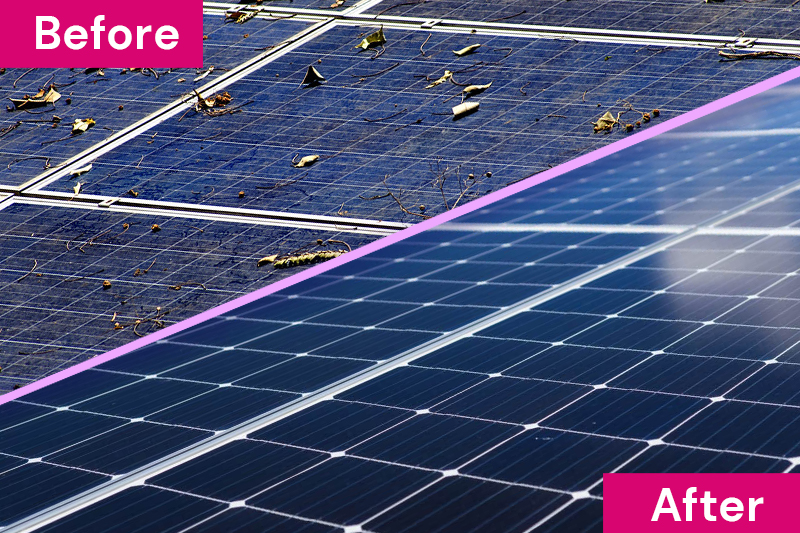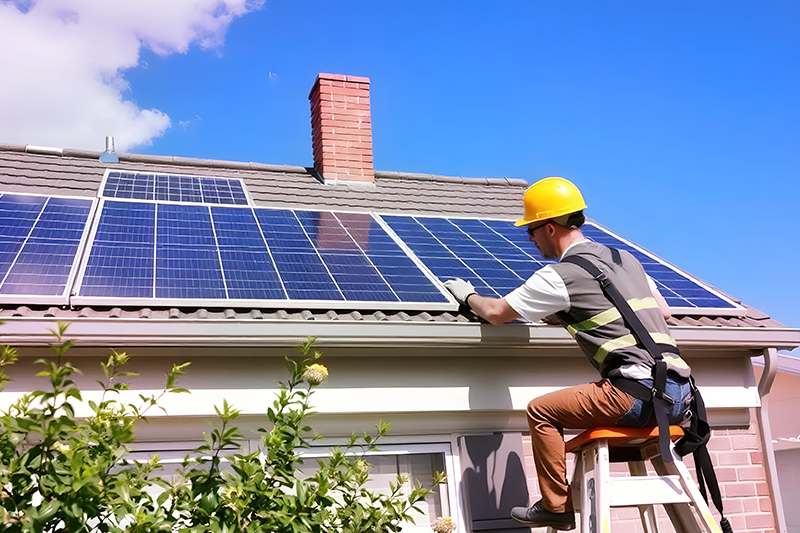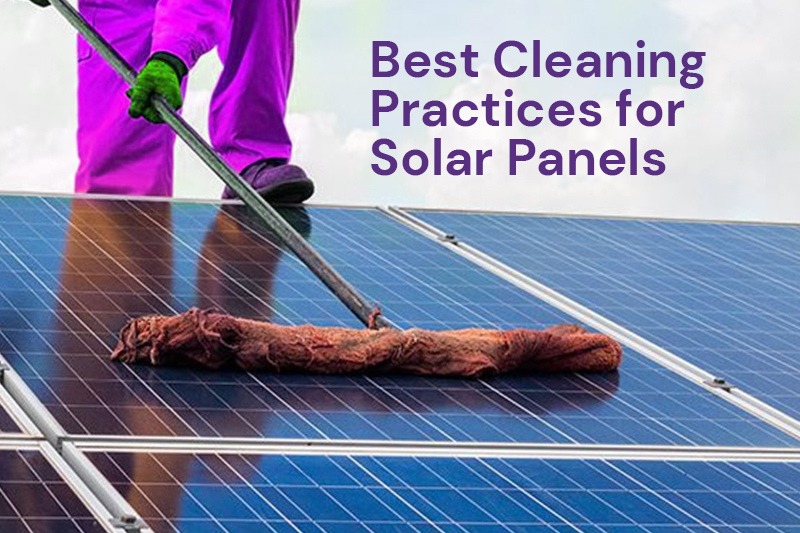Solar power has become an increasingly popular renewable energy option in Australia. Most of the country’s population embraces this clean energy source to lead a sustainable lifestyle.
Whether you are a seasonal solar enthusiast or a new bee to the solar energy world, remember that installing solar panels alone is not enough. They require proper care and maintenance to perform efficiently for long days.
Curious to know more about DIY solar panel maintenance? You have come to the right place!
In this blog, we’ll explore the essential DIY solar panel maintenance tips and some of the best practices for cleaning solar panels effectively.
So, without any further ado, let’s begin our journey!
Importance of Solar Panel Maintenance: Maximizing Your Solar Investment
Imagine your solar panel working at its peak, transforming all the captured sunlight into clean, accessible, free energy. Sounds great, right?
To make this vision into reality and make the most out of them, you need to give them the care and protection they deserve.
Proper solar panel maintenance isn’t just a chore; it helps the solar panel work smoothly, enhances efficiency and brings long-term savings to your solar investment.
By following a few tips for solar panel maintenance, you can keep your panel sparkling and power flowing throughout the years. Besides, appropriate care can significantly extend the panel’s lifespan and increase energy production by around 15%.
Are Solar Panels Easy To Maintain?
Maintaining solar panels is pretty simple and follows a few easy steps. Due to durable materials and low intervention, they don’t need daily interaction after panel installation.
Their specific mounting design and smooth surface also offer a self-cleaning effect, while their minimal moving parts reduce the likelihood of mechanical faults.
But keep in mind that solar panels are not totally maintenance-free. Minimal DIY solar panel maintenance can obtain the best return on this investment. This includes cleaning, periodic visual inspection, performance monitoring and so on.
How Often Do the Solar Panels Need to Be Cleaned and Maintained?
In general, solar panels perform well when cleaned once or twice a year. However, this cleaning frequency can vary depending on other factors, such as your geographic location, local climate and environmental conditions around the installation site.
Let’s have a clearer view: Suppose you live beside an ongoing construction site or areas with heavy snowfall. In this scenario, dust or snow will accumulate faster on your panel, thus requiring more frequent cleaning than usual.
Too much dust and debris, combined with long-term negligence in solar panel maintenance, can drastically ruin your system and hamper its efficiency.

Signs that say Solar Panel Needs Maintenance or Replacement
Are you noticing a significant drop in the electricity generated compared to what you expected from your solar panel? This might be a sign!
Knowing when the solar panels need maintenance or replacement can keep you updated on any upcoming technical issues. It helps address the problem more efficiently and prevents significant damage to the panel.
Here are some indications that say your solar panels may need maintenance:
- A sudden drop in performance and inconsistent energy output indicates your panel or solar battery needs maintenance.
- Inspect your panels for any visible cracks or broken glass patterns. Any physical damage on the panel can reduce efficiency and require immediate attention.
- Check for loose, missing, or damaged mounting hardware or other components during less efficiency.
- Getting error messages or unusual noises from the solar inverter.
- Visible damage, leaks, or corrosion on wires can reduce the solar panel’s performance.
- During severe weather, post-storm damage can impact the system, which needs to be appropriately maintained.
- Random notifications of solar panel issues and performance from the monitoring system.
- An increased energy bill despite having solar panels is another sign that explains that your panel needs maintenance.

Benefits of DIY Solar Panel Maintenance
Over the past decades, the increased use of solar panels in Australia has offered numerous benefits to the country’s individuals and communities.
Installing and properly maintaining solar panels can reduce carbon footprints. These practices also help the planet stay healthy and green, supporting your commitment to sustainability.
However, self-maintenance or DIY solar maintenance is an excellent option with many practical and financial benefits.
DIY solar maintenance means you perform the maintenance task all by yourself without any technician’s help. This saves money, as you don’t need to pay for professional checks or services for minor repairs.
Regular maintenance and early problem detection maximize energy production and increase the solar panel’s lifespan, mitigating the replacement cost.
Performing maintenance gives you a better understanding of how your solar panel works. This knowledge can be empowering and help you make informed decisions about repairs or upgrades.
DIY maintenance allows you to work on your panels according to your schedule. Instead of coordinating with a service provider’s availability, it offers time flexibility.
Wondering why and when to ask for professional help? Just remember that even if you can maintain and fix basic solar panel issues, there are some intricate ones that require expert hands.
In such cases, consider consulting with Solar Emporium. We offer tailored solar solutions to meet your specific solar needs.
8 DIY Solar Panel Maintenance Tips for Australians
After knowing all the basics, it’s time to delve into the main part: essential DIY solar panel maintenance tips.
Here is a comprehensive solar panel maintenance checklist tailored according to Australian conditions.
Regular Cleaning and Pest Control: Regular cleaning for dust, pests or bird droppings on the solar panel can enhance solar energy production. As suggested, 3 to 4 times of periodic checks is enough in a year. Also, it’s best to surround the area with a mesh or net to prevent any harm from pests.
Inspecting Panels for Damage: Ensure visual inspection for common types of damage, like scratches, corrosion, or cracks on the panel. If the panel is mounted on the rooftop, check the roof’s compatibility occasionally.
Performance Check for Inverters: Use innovative tools to monitor solar panel performance. Check if your inverter converts the DC electricity into AC electricity correctly. Also, look for any potential alerts or signals.
Check for Shadings or Other Obstacles: Overhanging branches or skyscrapers can cast shadows on your panels, preventing sunlight from reaching the panel’s surface. Regularly trim branches to prevent them from shading the solar panels.
Monitoring System Performance: Use a solar monitor or inverter’s performance data to check for any drop in output. This can immediately indicate any issues related to wire connections, solar batteries or inverters.
Proper Ventilation: Without proper air circulation, your solar panels can overheat, so allow proper ventilation for the best outcome.
Safety Measures: If your panels are on the roof, avoid climbing them yourself. Use help for safe maintenance. Also, be cautious when handling any electrical components.
Keep Proper Documentation: Maintain records or documents of inspections, cleaning, and any maintenance or repairs performed. This can be useful for troubleshooting and when dealing with warranties.
Maintenance Tips for Solar Panels Depending on Australia’s Seasonal Variation
Besides essential DIY upkeeping, the solar maintenance process varies with seasonal changes. Different and extreme weather conditions like drought, wind, and snow can damage the panel and make it less efficient.
Let’s explore how! Shall we?
Solar Panel Care on Spring Time
- Look for any visible signs of damage, such as cracked panels, loose mounts, or broken wiring, in spring, as it is the best time.
- Manufacturers and solar panel installer companies prefer this time of the year for effective maintenance and cleaning of solar panels.
- Spring is all about renewal and rebirth. So, evaluate whether newly grown leaves or structures have started to cast shadows on your panels.
Summer Days Solar Maintenance
- Even though high-quality and efficient solar panels can withstand extreme temperatures, overheating during summer can slightly reduce their efficiency.
- Ensure the panel gets enough ventilation to avoid overheating or damage issues.
- Insects or birds can also destroy wires and other solar panel components, which must also be considered during maintenance.
- Remove summer dust, pollen, or bird droppings that may have accumulated on the panel, hindering the efficiency.
Winter Effects on Solar Panels
- Australian states like New South Wales (NSW), South Australia and Victoria undergo heavy snowfall during the winter season. It can be a significant problem for people as snow blocks the sun’s rays, reducing energy production.
- Use a soft brush and plastic shovels or pour mild to lukewarm water to remove snow from the panel.
- Avoid pouring hot water directly onto the panel, as it can destroy or crack due to sudden temperature fluctuation.
- Inspect and ensure that water from melting snow can run off and drain properly without any obstacles.
Fall Preparation
- Autumn comes with winds and storms where dry leaves fall everywhere. So, try to remove any falling leaves and debris that may obstruct sunlight or affect drainage.
- Ensure all components are secure and perform well.
- Secure any loose wiring and perform visual inspections to make necessary adjustments to the system for upcoming winter conditions.

Best Cleaning Practices for Solar Panels in Australia
Want your solar panels to shine as bright as the sun?
Discover the secret to maximizing your solar panel’s efficiency by mastering these essential DIY cleaning practices.
So, here is a table that lists the things to maintain for spotless solar panels and also some specific measures that must be skipped for a smooth solar experience.
What is the Best time to Clean Solar Panels in Australia?
Australia?
Looking for the best season in Australia to clean your solar panel?
The best season to clean solar panels in Australia could be Autumn or Spring. The weather is typically mild at this time, and there is no risk of direct sun exposure, which causes cleaning solutions to dry quickly.
Choosing the time of day can also help in effective solar panel cleaning. Early morning or late afternoon is ideal, as the panels stay much cooler than during peak sun hours. It reduces the chance of thermal shocks and prevents any damaging issues.
For any solar-related query, contact Solar Emporium today and get a free solar quote.







